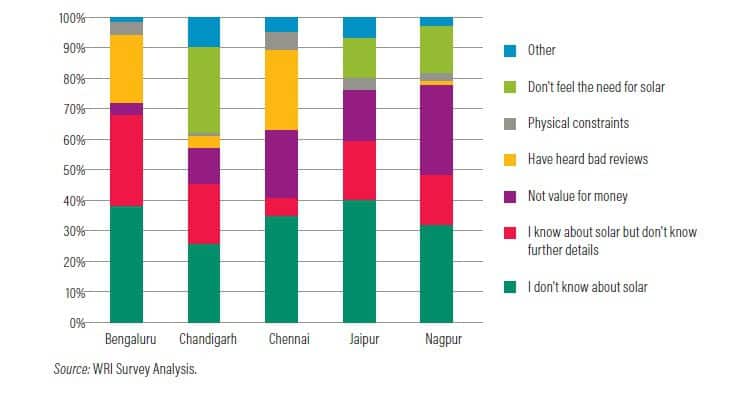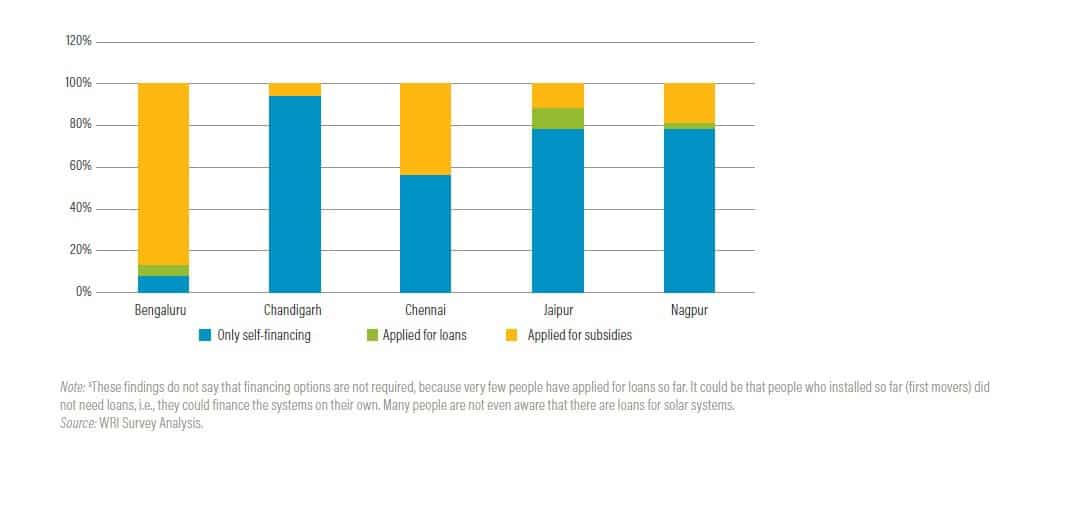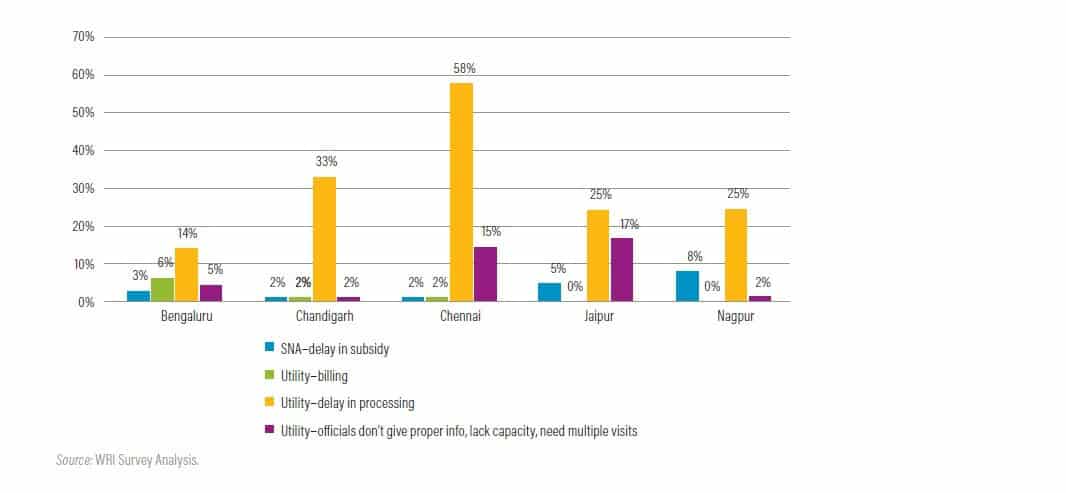When Heather Ramaswamy, a resident of Bengaluru, decided to construct her house three years ago, rooftop solar PV was the first thing on her mind. Following days of research over the Internet, Heather zeroed in on an American company. Committing to an upfront cost of Rs 4 lakh, Heather got four solar panels installed on her slanting rooftop and thus began her series of never-ending ordeals.
“You think that you did something good for the environment till it backfires on you. We got an off-grid unit, which was supposed to meet our power requirements. We had the on-grid system in mind during our planning phase, but could not get it done in the absence of reliable information on vendors. We decided to go ahead with an American vendor but landed up with a series of issues post installation,” says Heather.
Dealing with never-ending battery failures and lousy post installation service, Heather says, she would never go for the rooftop solar panels again even if she had a chance.
“More than the money, it is the frustration that bothers you, because your unit is just not functioning properly. Despite having solar panels and BESCOM (Bangalore Electricity Company) connection to power our home, we spent countless nights in darkness due to faulty batteries. I blame it on lack on information on reliable vendors and no other source of information other than the vendor, who put up the unit for you,” says Heather.
The issues pointed out by Heather are only a couple of the problems plaguing the residential rooftop solar project in India. Lack of clear information about solar panels and reliable vendors, lack of knowledge on process of installation, confusion over the approval process, insufficient financing options and glitches in coordination among the government agencies are some more reasons that are behind the crawling pace of uptake in the residential rooftop solar sector.
This is borne out by a study conducted by World Research Institute (WRI), India in association with Shakti Sustainable Energy Foundation.
The evidence-based study surveyed 1808 households across five cities in India over a period of three months (November 2017 – January 2018) to document the experience of people during and after installation of the rooftop solar panels on their houses.
Conducted in Bengaluru, Chandigarh, Chennai, Jaipur and Nagpur, with around 360 households in each city, the study highlights various challenges that the residential rooftop solar sector is facing, in turn dampening India’s ambitious target of achieving 175 GW of renewable energy capacity by 2022.
As per the government’s current plan, 40 GW of the proposed capacity has been allotted to rooftop solar PV. It should be noted that the total rooftop capacity currently is mere 1.222 GW, with residential rooftop solar contribution standing at just 0.37 GW.
The study surveyed households that have installed solar PV (325 households), those that are considering the installation (223) and also those that are not considering installation of solar PV (1260 households) on parameters such as availability and accessibility of clear information for installation, challenges of accessing information, availability of financing options and role of government agencies in making the process easier for the households.
Lack of awareness
Findings indicate that the awareness level among households that have not installed rooftop solar PV is very low.
According to the report, as many as 70% of the households that plan to install rooftop solar panels did not know the difference between solar water heater and solar rooftop PV for electricity generation. They were also unaware about how solar PV works.
A city-wise analysis shows that the awareness level was lowest in Jaipur, where 40% of respondents said they did not know anything about solar, and the highest in Chandigarh, though even in that city around 25% said they had no knowledge. (Figure 1). Across the five cities surveyed, around 53 percent of consumers who hadn’t considered solar PV was either because they did not know about solar, or did not know enough details to consider solar.

Reasons for not considering rooftop solar.
Source: Here Comes the Sun: Residential Consumers’ Experiences with Rooftop Solar PV in Five Indian Cities,” Working Paper. Bengaluru: World Resources Institute.
Dearth of information
The study results show that even those who have the knowledge and desire to obtain green energy are deterred by either no information on the process or absence of reliable sources to guide them through it.
Verification of the price quoted by vendors for the installation process turned out to be the most difficult step across all five cities.
Around 46% of respondents faced problems in obtaining information about the technology. On an average, 45% of the households with solar PV were completely reliant on the vendors for any kind of information. To make matters worse, many faced problems with verifying the vendors and the price quoted by them.
Chennai led the way at 69% of the respondents who said they have faced problems in verifying whether the vendor was trustworthy or if the price offered was right. While this number of baffled customers stood at 47% in Bengaluru, it was less than 35% in rest of the three cities.
Accessing information
When it comes to accessing information being made available by the government on rooftop solar PV installation, the Ministry of New and Renewable Energy’s (MNRE) ARUN (Atal Rooftop Solar User Navigator), a web based application, offers basic knowledge about rooftop solar and provides quick calculations on installation costs and updates on the regulatory ecosystem in the country. There is also SPIN — an online application for solar PV installation for grid connected systems. But these, in general, had little impact on uptake, owing to small number of people reaching out through these mediums. Only 19% of the surveyed households looked up the Internet for information on rooftop solar PV installation.
Absence of customized financing options
The survey highlights that financing options like loans from banks and subsidies provided by the government is not very popular among households that have already installed rooftop solar PV or are planning to do so. It could be because the first movers did not require any loans as they could finance their systems on their own. When it comes to subsidies, most people are not even aware that there are loans available for solar support.

Financing modes adopted across cities.
Source: Here Comes the Sun: Residential Consumers’ Experiences with Rooftop Solar PV in Five Indian Cities,” Working Paper. Bengaluru: World Resources Institute.
City-wise analysis shows (Figure 4) that awareness regarding the subsidy and loans for solar PV installation was highest in Bengaluru, followed by Chennai, Nagpur, Jaipur and Chandigarh, respectively.
Challenges in interacting with agencies
During rooftop solar PV installation, electricity utilities and the State Nodal Agency (SNA) are the main institutional players that the consumer deals with. These agencies are involved in the entire process, right from the outset. Moreover, a grid-connected installation requires multiple approvals from various government agencies including utilities and SNAs.
The study shows a number of challenges that consumers faced with government agencies. The most common were delays in processing subsidy and net-metering applications, challenges in billing, requirement of multiple visits for approvals and the lack of capacity of the officials to provide sufficient information and guidance.

Challenges in dealing with institutions. Source: “Here Comes the Sun: Residential Consumers’ Experiences with Rooftop Solar PV in Five Indian Cities,” Working Paper. Bengaluru: World Resources Institute.
When it comes to dealing with government agencies during approval processes, Chennai flaunted the worst report card with highest instances of delay by the Utility (58%) in processing the request, followed by Chandigarh (33%), Jaipur (25%), Nagpur (25%) and Bengaluru (14%).
However, the city performed far better with respect to release in subsidy (by the SNA). Only 2% of the respondents from Chennai reported delay in receiving subsidies. Maximum instances of subsidy delay were reported in Nagpur (8%).
What is the way forward then?
With little information available in the public domain, those who want to solarize their rooftop did not get much respite by reaching out to officials too. 17% of the respondents in Jaipur said that they did not get proper information from the officials regarding the process, and so did 15% from Chennai, 2% each from Chandigarh and Jaipur and 5% from Bengaluru.
Under the given circumstances, the study suggests following measures to help more households opt for cleaner source of energy:
- Effective dissemination of objective information
- Easy accessibility of information to consumers
- Local information campaigns for awareness
- Customized offerings and competitive rates for financing
- Hasslefree processes for billing and approvals
[All data and graphs have been taken from: Devi, A., U. Narayan, and T. Mandal. 2018. “Here Comes the Sun: Residential Consumers’ Experiences with Rooftop Solar PV in Five Indian Cities,” Working Paper. Bengaluru: World Resources Institute]
The article Solar rooftop connections: Why are city homes lagging? makes an interesting reading. But my experience (I am also living in Bengaluru since March 2005) is different. I came to know of Solar Power Generation only during March 2017 and I called one Service Provider and signed the agreement on the same day and paid him (in fact he used my computer to print the proposal/agreement in my home).
I did not go for hybrid system. So for me no maintenance is involved. I export to grid and I have backup generator. My return of investment is over 12% tax free and my buy back is 7 years.
Today I am really going out of my way to popularise Solar Power Generation for one simple reason : Any electricity bill paid is a money wasted (or putting it in drain). If you take 50K + crore paying electric bills and average is taken as Rs.5K per month it is coming to a huge huge wastage of 30,000 crores in a year.
Solar Rooftop systems use endless energy of Sun to power your home and 1 kw of system can save upto to 2000 kg of C02 emissions in a year.
Uberimme fidie (Buyer beware) applies not only for solar power production; for that matter anything. From the above rough calculations, in 10 years we would have saved 300,000 crores for more productive usage. Personally I would have not only recovered by capital investment but also would be enjoying free electricity life long and also contribute to the Go Green project.
I feel we should fully utilise Sun God’s bounty and export to grid. Today a 1 kva system capable of producing 150 units in a month in Bengaluru (Chennai may be blessed with more production units) and the WHOLE cost including A to Z approvals, installations etc. will cost less than the price of a latest Iphone or Samsung S9. (Add additional amount if you want to go for hybrid system). We have real good dealers in Bengaluru.
I do not mind your sharing my email id to any one interested in talking to me: ibmnarayan@gmail.com
I agree with the above research, many difficulties were faced by the end user due to lack of knowledge & requirement assessment before installing the solar rooftop installation. As now we have many service providers & solar PV Experts & specialists who have made the job easy and provide a quick & reliable tailor-made product for the end user. Many Govt based schemes are available & Solar PV installation made affordable from MNRE.
It is unfodtunate that Heather Ramaswamy was put to a lot of inconvenience. Since she spoke of battery failures I suppose she chose hybrid system. I checked with one System Integrator. His comments are:
“Yes hybrid systems are harder to design and better quality materials are needed. But it is certainly not undoable or unsuccessful”.
Also your observation in the article about insufficient training give for bi-directonal meter reading appears valid. I am sure and pray that the GOI will take up solarization on a war footng because of its advantages. From my side I have tweeted top Ministers and MPs giving link of your great article.